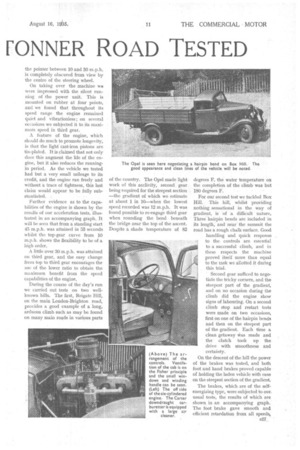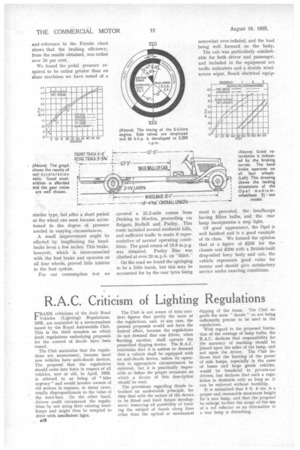THE NEW OPEL
Page 36

Page 37

Page 38

If you've noticed an error in this article please click here to report it so we can fix it.
FONNER ROAD TESTED
The Opel, a German Product of the General Motors Corporation of America, Now Being Marketed in This Country, is of Sturdy Design and Puts up a Good All round
AS announced in the issue of The Commercial Motor dated April 26 last, the Opel 2i-tonner, which is built by the famous German concern, now under the control of the General Motors Corporation of America, is now being marketed in this country. The concessionnaire for the vehicle in Great Britain is Oldsmobile and Opel Distribut,rs, Ltd., Terrell's Wharf, Fulham, London, S.W.6, and a machine was placed at our disposal for the purpose of a road test by the distributor, L. C.
Rawlence and Co., Ltd., 39, Sackville Street, London, W.1.
The chassis is available in three lengths of wheelbase and it is the medium-wheelbase model, equipped with a German-made body and cab, that forms the subject of our test. It is intended to import only the chassis, a range of British-built bodies being available on each of the three models.
A feature of the chassis is its light weight. The model tested weighs but 31 cwt., so that complete with body and cab the vehicle turns the scale at under 2 tons and is thus subject to a tax of 225.
With the longest chassis of 15-ft. 3-in, wheelbase, the unladen weight of the complete vehicle is well under 2i. tons and a body space of no less than 14 ft. 6 ins, is available, despite the fact that normal control is used.
Equipped with a powerful six cylindered engine developing nearly 70 b.h.p. the chassis is sturdily built throughout, and during our test we formed the impression that the vehicle is fully deserving of the popularity which it has gained in its country of origin. It performed creditably throughout the test, and proved delightfully easy to drive. In this connection, it is worthy of mention tha.t the controls are well arranged, and a comfortable driving position is afforded.
One criticism does, however, come to mind, in that, for operation in this country, an improvement could be effected by the placing of the speedometer in a more visible position. As at present mounted the movement of the pointer between 10 and 30 m.p.h. is completely obscured from view by the centre of the steering wheel.
On taking over the machine we were impressed with the silent running of the power unit. This is mounted on rubber at four points, and we found that throughout its speed range the engine remained quiet and vibrationless; on several occasions we subjected it to its maximum speed in third gear.
A feature of the engine, which should do much to promote longevity, is that the light cast-iron pistons are tin-plated. It is claimed that not only does this augment the life of the engine, but it also reduces the runningin period. As the vehicle we tested had but a very small mileage to its credit, and the engine ran freely and without a trace of tightness, this last claim would appear to be fully substantiated.
Further evidence as to the capabilities of the engine is shown by the results of our acceleration tests, illustrated in an accompanying graph. It will be seen that from a standing start 45 m.p.h. was attained in 53 seconds whilst the top-gear curve from 10 m,p.h. shows the flexibility to be of a high order.
A little over 30 m.p.h. was attained on third gear, and the easy change from top to third gear encourages the use of the lower ratio to obtain the maximum benefit from the speed capabilities of the engine.
During the course of the day's run we carried out tests on two wellknown hills. The first, Reigate Hill, on the main London-Brighton road, provides a good example of a long, arduous climb such as may be found on many main roads in various parts of the country. The Opel made light work of this acclivity, second gear being required for the steepest section —the gradient of which we estimate at about 1 in 10—when the lowest speed recorded was 12 m.p.h. It was found possible to re-engage third gear when rounding the bend beneath the bridge near the top of the ascent. Despite a shade temperature of 82
degrees F. the water temperature on the completion of the climb was but 180 degrees F.
For our second test we tackled Box Hill. This hill, whilst providing nothing sensational in the way of gradient, is of a difficult nature. Three. hairpin bends are included in its length, and near the summit the road has a rough chalk surface. Good handling and quick response to the controls are essential to a successful climb, and in these respects the machine proved itself more than equal to the task we allotted it during this trial.
Second gear sufficed to negotiate the tricky corners, and the steepest part of the gradient, and on no occasion during the climb did the engine show signs of labouring. On a second climb stop and restart tests were made on two occasions, first on one of the hairpin bends and then on the steepest part of the gradient. Each time a clean getaway ikas made and the clutch took up the drive with smoothness and certainty.
On the descent of the hill the power of the brakes was tested, and both foot and hand brakes proved capable of holding the laden vehicle with ease on the steepest section of the gradient.
The brakes, which are of the selfenergizing type, were subjected to our, usual tests, the results of which are shown in an accompanying graph. The foot brake gave smooth and efficient retardation from all speeds,
and reference to the Ferodo chart shows that the braking efficiency, from the results obtained, was rather over 50 per cent.
We found the pedal pressure required to be rather greater than on thine machines we have tested of a similar type, but after a short period at the wheel one soon became accustomed to the degree of pressure needed in varying circumstances.
A small improvement might be effected by lengthening the handbrake lever a few inches. This brake, however, which is interconnected with the foot brake and operates on all four wheels, proved little inferior to the foot system.
For our consumption test we covered a 25.2-mile course from Dorking to Morden, proceeding via Reigate, Redhill and Purley. This route included several moderate hills, and sufficient traffic to make it representative of normal operating conditions. The good return of 13.8 m.p.g. was obtained. Purley Rise was climbed at over 20 m.p.h. on "third."
On the road we found the springing to be a little harsh, but this may be accounted for by the rear tyres being somewhat over-inflated, and the load being well forward on the body.
The cab was particularly comfortable for both driver and passenger, and included in the equipment are traffic indicators and a double windscreen wiper. Bosch electrical equip ment is provided, the headlamps having Bilux bulbs, and the rear lamp incorporates a stop light.
Of good appearance, the Opel is well finished and is a good example of its class. We formed the opinion that at a figure of £256 for the chassis and £296 with a British-built drop-sided lorry body and cab, the vehicle represents good value for money and should give satisfactory service under exacting conditions.




















































































